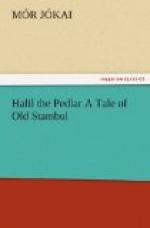On the eve of the Prophet’s birthday about fifty plants had begun to bloom, all of which had been named after battles in which the Mussulmans had triumphed, or after fortresses which their arms had captured. Then, however, the Kapudan Pasha was obliged to go to sea and command the fleet, in other words, he was constrained to leave his beloved tulips at the most interesting period of their existence.
On the very evening when the Sultan arrived at Scutari, one of the Kapudan Pasha’s gardeners came to him with the joyful intelligence that Belgrade, Naples, Morea, and Kermanjasahan would blossom on the morrow.
The Kapudan Pasha was wild with impatience. There they all were, just on the point of blooming, and he would be unable to see it. How he would have liked a contrary wind to have kept back the fleet for a day or two.
But what the wind would not do for him, the Sultan’s birthday gave him the opportunity of doing for himself. The day of rest appointed for the morrow permitted the Kapudan Pasha to get himself rowed across to his summer palace at Chengelkoei, where his marvellous tulips were about to bloom at the beginning of autumn.
What a spectacle awaited him! All four of them, yes, all four, were in full bloom!
Belgrade was pale yellow with bright green stripes, those of the stripes which were pale green on the lower were rose-coloured on the upper surface, and those of them which were bright green above died gradually away into a dark lilac colour below.
Naples was a very full tulip, whose confusingly numerous angry-red leaves, with yellow edges, symbolized, perhaps, the fifteen hundred Venetians who had fallen at its name-place beneath the arms of the Ottomans.
Morea was the richest in colour. The base of its cup was of a dark chocolate hue, with green and rose-coloured stripes all round it; moreover, the green stripes passed into red, and the rose ones into liver-colour, and a bright yellow streak of colour ran parallel with every single stripe. On the outside the green hues, inside the red rather predominated.
But the rarest, the most magnificent of the four was Kermanjasahan. This was a treasure filched from the garden of the Dalai Lama. It was snow-white, without the slightest nuance of any other colour, and of such full bloom that the original six petals were obliged to bend downwards.
The Kapudan Pasha was enraptured by all this splendour.
He had made up his mind to present all these tulips to the Sultan, for which he would no doubt receive a rich viceroyalty, perhaps even Egypt, who could tell. He therefore ordered that costly china vases should be brought to him in which he might transplant the flowers, and he dug with his hands deep down in the soil lest he should injure the bulbs.
Just as he was kneeling down in the midst of the tulips, with his hands all covered with mould, a breathless bostanji came rushing towards him at full speed, quite out of breath, and without waiting to get up to him, exclaimed while still a good distance off:




